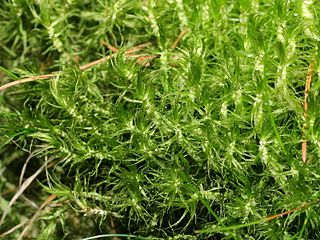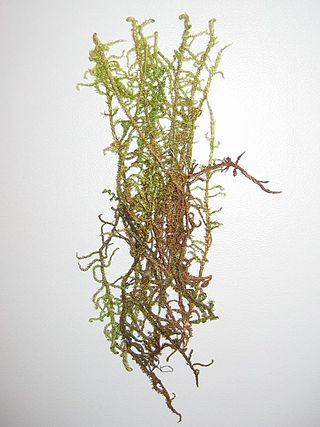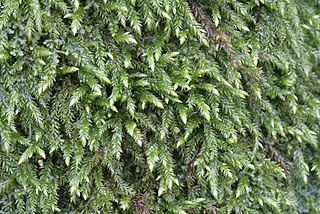
Funaria is a genus of approximately 210 species of moss. Funaria hygrometrica is the most common species. Funaria hygrometrica is called “cord moss” because of the twisted seta which is very hygroscopic and untwists when moist. The name is derived from the Latin word “funis”, meaning "a rope". In funaria root like structures called rhizoids are present.

Dicranum is a genus of mosses, also called wind-blown mosses or fork mosses. These mosses form in densely packed clumps. Stems may fork, but do not branch. In general, upright stems will be single but packed together. Dicranum is distributed globally. In North America these are commonly found in Jack pine or Red pine stands.

Porella is a large, common, and widespread genus of liverworts in order Porellales. It is a member of the family Porellaceae within that order.

Grimmia is a genus of mosses (Bryophyta), originally named by Jakob Friedrich Ehrhart in honour of Johann Friedrich Carl Grimm, a physician and botanist from Gotha, Germany.

Ditrichum is a genus of haplolepideous mosses (Dicranidae) in the family Ditrichaceae.

Tortula is a genus of mosses in the family Pottiaceae.

Thuidium is a genus of moss in the family Thuidiaceae. The name comes from the genus Thuja and the Latin suffix -idium, meaning diminutive. This is due to its resemblance to small cedar trees.

Leucobryum is a genus of haplolepideous mosses (Dicranidae) in the family Leucobryaceae. The name comes from the Greek leukos, meaning white, and bryon, meaning moss.

Plagiomnium is a genus of mosses in the family Mniaceae. It was formerly a part of a more encompassing genus Mnium and in 1968 Finish bryologist Timo Juhani Koponen justified splitting the genus into a number of smaller genera.
Gigaspermum is a genus of moss in the family Gigaspermaceae. It contains four species.

Plagiothecium is a genus of moss belonging to the family Plagiotheciaceae. It has a cosmopolitan distribution.
Campylium elodes is a species of moss belonging to the family Amblystegiaceae.

Drepanocladus is a genus of mosses belonging to the family Amblystegiaceae. It has a cosmopolitan distribution

Isothecium is a genus of mosses belonging to the family Lembophyllaceae. The genus has a cosmopolitan distribution.

Rhizogonium is a genus of mosses belonging to the family Rhizogoniaceae.
Pylaisia is a genus of mosses belonging to the family Pylaisiaceae.

Hypnodendraceae is a family of mosses belonging to the order Hypnodendrales.














